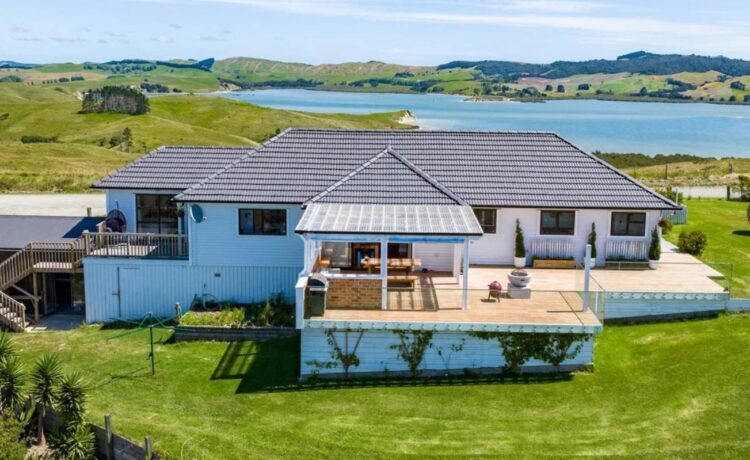David Thomson is stuck paying a home loan interest rate of 13.6% on a house that was meant to be his retirement plan, which he now cannot sell.
The 59-year-old builder and his wife worked evenings and weekends for seven years, building their home on a 17.5-acre property near Kaiwaka, north of Auckland, while also working full-time.
They were not able to get a standard bank loan for the property, and took second-tier financing at 8.5%. Second-tier lenders offer loans to people who cannot get lending from mainstream banks, but generally charge higher interest rates in return.
When they finished the house, they had a $400,000 debt but the property was valued at $875,000, which Thomson said was due in large part to the hard work they had put in.
“The tiles on the laundry floor, the glue was $150 a bag. I mixed up too much glue and couldn’t afford to throw it away so my wife was spoonfeeding me my dinner at 8pm because I couldn’t stop working or I would throw $150 of glue away. We have strived very hard to get this far. It’s a hard pill to swallow to have to lose it.”
Thomson said he thought it would be easy to get a loan at that point but they were not able to because he was self-employed.
But the couple discovered, as the housing market started to accelerate towards its recent peak, they could subdivide the property.
They took second-tier lending to do so, because the bank again was not interested and said his income did not meet stress tests. Their floating rate was initially 10.5% but has now gone up to 13.6%.
“Everything was going up, interest rates were at the floor, house prices were through the roof so we went down that path, we got floating second-tier lending. But then the housing market plummeted and interest rates skyrocketed.
“We had this plan that when everything was going really good, we subdivide and then we’ll sell this house, we’ll build a house on the first section, live on it for two years because that’s the length of the bright-line test, and then by the time we do the second house we’ll have recovered our costs and we’ll actually have some cash and I’ll be able to retire at about 62.
supplied
The house was a huge project for the couple, Thomson said.
“When you’re a kid and you decide to be a builder, even when you’re in your 30s and 40s, you don’t think about what it’s like when you’re 59 trying to carry timber around, climbing scaffolding and running around on rooves. Then the bright-line turned into a 10-year thing and the whole business plan wasn’t viable.”
The subdivision took twice as long as they expected and cost three times as much, leaving them with a debt of $960,000. Getting power to the new sites alone cost $76,000. The new sections did not sell.
“Something I didn’t appreciate at the time was that every Mum and Dad who could did exactly the same thing. There are so many sections on the market – or not even on the market, because it’s not worth putting them on. We’ve had them on the market twice.”
He said he had contemplated building houses on the site to sell but agent appraisals had indicated they would not make more than they cost to build. “We need to dig ourselves out of the hole before we lose everything. I’m a $55-an-hour builder and we are only paying half of the interest on the loan, the other half gets tacked on top of the loan. I only earn $1740 a week after tax and the repayments are $2260.”
Thomson’s wife was made redundant and the couple can only pay $1100 of interest a week. The rest gets added to the principal.
Stuff
The Government announced in March it was extending the bright-line test, reducing tax deductions on property investments, and would step up investment in communal infrastructure to support housing developments.
“Our beautiful home has been on the market since March. We will lose it all by this March if we cannot sell.”
The property was listed at $1.35 million but has since dropped to $1.150m. “If we go any lower we’ll be giving it away.
“We’re just two gumboot people who worked extraordinarily hard to get where we are and got knobbled by government policy.”
He said in an ideal world they would now rent the property out for now and then refinance when things improved to put a relocatable house on another of the sections, sell it to a first-home buyer and clear some of the debt.
At that point, he hopes, he might be able to go to the bank and get a standard mortgage. “So we can pay normal money instead of getting fleeced by second-tier lenders because that’s the only option open to us.”
Mortgage broker Glen McLeod said a lot of people were in a similar situation to Thomson.
“More by the day. I’m seeing a real influx of issues. I had one today who came to me and he’s behind on his mortgage, behind on rates, behind on everything. He’s let the house insurance go … I’ve said ‘get that sorted back today because if there’s a fire you lose all your money’. Because of his credit check, he’ll have to go second-tier.
“There’s quite a few people who have struggled because of Covid because their financials are not great, they’re still recovering. Everyone thinks Covid’s gone, it’s not. Some industries had a hangover after that year to two years after lockdown was finished. They’re only just getting back now. These places are becoming more and more needed.”
McLeod said he had had some success in helping negotiate a lower rate for people who were in difficult positions. “It just comes down to how bad was the credit check. What was the credit issue that was there.”














